
ARTICLES |
Patterns: Telling it like it is The Sine Wave! by Stuart Anslow III |
** VIDEO CLIPS ** Rayners Lane Students performing patterns along side students performing sine wave (B!) patterns at a recent tournament! Won-Yo Tul - 1.96Mb Rayners Lane Student Bako Kadir performs Won-Yo Tul (Starts left of screen). Notice the difference in speed & power in excecution of techniques, especially notice the side piercing kicks! Yul-Guk v Hwa-Rang - 2.91Mb Rayners Lane student Colin Avis (starts right of screen) performs Yul-Guk Tul. Again, notice the difference in both speed & power of execution Toi-Gye v Choong-Moo - 2.91Mb Rayners Lane student Dev Patel (starts right of screen) performs Toi-Gye Tul against an opponent who perfroms sine wave more adequetly Joong-Gun v Yul-Guk - 4.71Mb Rayners Lane student Justin Goh (Starts left of screen) performs Joong-Gun Tul, here you can notice a big difference in stability! Hwa-Rang v Choong-Moo - 3.24Mb Rayners Lane student Parvez Sultan (Starts on right of screen)performs Hwa-Rang Tul. You can distinctly see the difference in speed of execution of technique & between movements Yoo-Sin v Ge-Baek - 4.40Mb Rayners Lane Instructor (and the articles author) Mr Anslow (starts left of screen) performs Yoo-Sin Tul. Although the opponent performs a good pattern, there is a distinct lack of fluidity between movements You should also note that every one of these patterns lost! Most lost to a majority of 5 - 0! Consequently, of the six coloured belt patterns performers above, 5 won medals in the sparring divisions, all 5 of which were golds!!! More patterns can be found in the videos section of this site Tim Murpthy, a former Taekwon-do instructor in Ireland recently (August 2005) carried out some tests to measure the power generated using TKD techniques. Though just a small test, the results tend to lend even more weight to the above article. Power Generated By Taekwon-Do Techniques By Use Of The Sinewave by Tim Murphy Testing was conducted to measure the power generated using various Taekwon-Do techniques. The aim of the test was to compare different methods of performing the techniques, namely using sine wave and without using sine wave. The apparatus used was a kick bag designed to measure the force at which it was being hit. The following techniques were tested; sitting stance punch, walking stance reverse punch, and a regular boxing style punch. Each punch was performed 4 times and an average was calculated. Each punch was performed with both left and right hands. Two subjects were used, both ITF black belts (one formerly ITF-C and the other person is with ITFNK). Test Results and Analysis Sitting Stance Punch Both subject’s punches with one hand were harder using the sine wave and their punches with the other were weaker using it. However the differences in power generated were small, as low as 0.25% in one case. On average, the difference in power generated using the sitting stance punch with and without sine wave was negligible. Walking Stance Reverse Punch One subject punched harder with one hand using sine wave and harder with the other without it. The other punched harder without sine wave with both hands. On average, the force generated from a reserve punch in walking stance without using the sine wave was 4% higher than the same technique using sine wave. Boxing style punch Subjects were required to assume a regular boxing style stance and punch from their back hand using standard boxing technique (i.e. hands up, chin down, turning shoulder into the punch etc). On average, this type of punch was found to be 30% more powerful than the traditional punches. Limitations of the testing Only two test subjects were used in the test. To obtain more accurate and comprehensive results a larger number of people would need to be tested. Only three techniques were used in the test. For the sake of simplicity three basic punches were tested. To give a broader overview of the use of sine wave in Taekwon-Do the test could be expanded to include other techniques. Conclusions Based on the results obtained, there is no evidence to suggest that techniques performed using the sine wave are more powerful than techniques performed without the sine wave. On average, techniques done without the sine wave were found to be 0.16% more powerful than those done with it. Both methods of performing traditional punches were found to generate significantly less power than a standard boxing style punch. Many thanks to Tim for allowing us to add his tests to the article. Tim can be contacted at the University Of Limerick Kick Boxing Club |


diagram 1 |
diagram 2 |
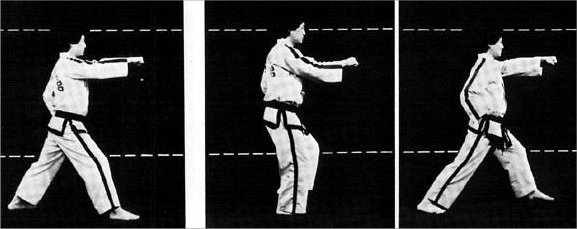
Correct motion using the sine wave, as originally put forth by General Choi, as in
diagram 1 |

Sine Wave 'A' (diagram 1 - left) verses Sine Wave 'B' (diagram 2 - right) using
basic reverse/obverse punch - based on speed of movement! |
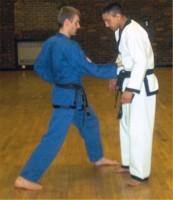
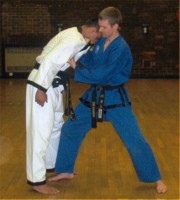
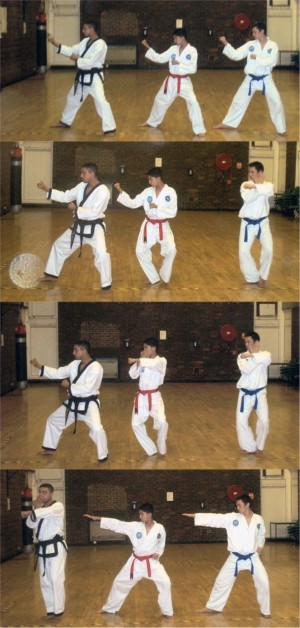
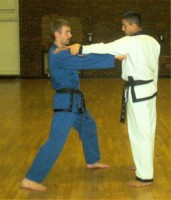
Example of speed aspects using Sine Wave B (diagram 2): left Horizontal Wave - middle Sine Wave A (diagram 1) - right in L Stance with an outward Knifehand Strike |
Hwa-Rangs Upward Punch |
Kwang Gaes Upset Punch |
Yoo-Sins Reverse Trap/Punch |
As printed in taekwon-do & Korean Martial Arts Magazine - February 2004 |
Recently I attended an event that showed me a mass of `sine wave` patterns on display,
which in turn prompted me to write this article. Many students simply don't understand the relevance of pattern practice, either why they do it, their purpose or what techniques are for! General Choi stated in his manual, under the section `Essential Information` with regards to patterns, that: 7. Students should know the purpose of each movement. 8. Students should perform each movement with realism. This article is not to discuss individual techniques contained within patterns (no 7), although a few might be highlighted within the context of this article, but to hopefully enlighten a few students as to `why we practice patterns`! However, the total, overall practice of patterns falls with no.8: Students should perform each movement with realism, and thus their pattern which of course contains 'each movement'! In this new era of three main ITF groups & many more independent Chang-Hon Taekwon-do schools there are now three main variations on the ITF tuls (when I refer to ITF I am not referring to any organisation, but to the style of Taekwon-do, ie. Chang-hon, which is mostly referred to as 'ITF style' whether correct or not) These three main variations can be seen as: 1.Very old, almost Karate type performance - emphasising lots of hip twist, off-turned shoulders & no knee-spring or sine-wave motions 2.Original, emphasising both hip twist & knee spring, but not sine-wave per se. 3.New, emphasising little or no hip twist or knee spring & lots of sine wave (as it is now taught!) First though, let me clear up why I refer to the above as very old, original & new. I refer to very old as 'very old' as I feel these patterns were stylised whilst Taekwon-do was still finding its identity & thus retain a lot of karate influences (which isn't a bad thing by the way), but in Taekwon-do terms they are old, the foundation you may say, but still needed further examination, study & development. I refer to original, as 'original', as they were refined versions of the 'very old', utilising hip twist still, but also using knee-spring etc. Movements were now more fluid & students were expected to retain a rhythmic motion in their pattern performance. This is where I believe Taekwon-do found its true identity! I refer to new as new as contrary to what many believe, the sine-wave has only been 'forcefully' pushed within Taekwon-do in the last 5 years or so (maybe less than that), maybe more so in other countries but not in the UK. So sine-wave patterns are a relatively new way of performance. So which way should you practice? Well this is a question that only instructors can answer, as for a student you have to follow your instructor, or as an instructor you have to follow your association & what they say they want! When I or my students have spoken to other students from other schools about pattern practice you often hear students say that patterns practice is for balance, poise, body shifting, smoothness, to develop rhythmic motion, to allow one to practice dangerous techniques without causing injury etc, Whilst all of the above may be true; they are all benefits of practicing patterns, they are not the foremost reason for pattern practice; they are extra beneficiaries of pattern practice. In Volume 1 of General Choi's encyclopaedia, under the section headed 'Patterns' (p154), General Choi states 'Patterns are various fundamental movements, most of which represent either attack or defence techniques, set to a fixed or logical sequence'. He further goes on to mention the other benefits of practicing patterns ie. Balance, poise etc. So it should be noted that before the extra benefits, it is stated that patterns represent self defence techniques, set out logically to aid the students practice If we look at the above statement and take no.8 of the 'Essential Information` on patterns, that we should practice with realism, then these few facts come into view: 1.To be realistic a technique needs to be fast, a slow technique simply will not work in 99% of cases (including blocks & strikes) 2.To be realistic a technique needs to be targeted (preferably to a vital or pressure point) 3.To be realistic a technique needs to be powerful 4.To be realistic a technique needs to be instinctive (especially in relation to blocking) So now we get into the controversial area of the sine-wave. As a note of interest sine-wave was introduced at a seminar in Derby by the General in 1983, but it was mentioned and not so forcefully pushed as it is now. So in reality it has been around in ITF Taekwon-do for over 20 years, but my instructor, nor his, nor I were told to perform patterns how they are performed now with the sine-wave, but more on this later. In the manual three waves (of motion/of movement) are given equal space; sine wave, horizontal wave & saw tooth wave (when was the last time you practiced this?). The horizontal wave is a straight line movement; the saw tooth wave is a straight up & down movement & the sine wave is represented as a slight up & down motion on a curve, which flows smoothly from one stance to the next, as in the diagram below (vol. 4, p.203). For examples, click here for video clips see bottom of article! |
So you would basically raise your body slightly when you move forward & drop as you
step into the stance. It is a smooth transition from one technique/stance to
the next. But, I have seen the sine-wave that is so heavily performed today by
dropping first, then raising up, the finally following the final (longer) curve,
down into the technique, making what students are calling sine-wave looking
something like this (although I'm no artist): |
Now compare that to the above version! It looks far from being a smooth flow! In
fact it is more like the saw tooth wave than the sine wave as General Choi described,
It should also be noted that General Choi said on the same page that "posture
A (the sine wave) is the only motion used in Taekwon-do". It should further
be noted that General Choi said "once the movement is in motion it is not stopped"
which is why, after seeing the article I found out that Adam Porter,
a current ITF direct Instructor feels most peoples sine wave is wrong & is more
akin to the saw tooth wave! This ITF instructor further states "General Choi
has taken his variation of this idea and labelled it 'sine wave.' But he did
not come up with this type of movement. I actually tell my students this and the
ones who train with other ITF instructors always suffer apoplexy!", he also goes
onto say "Examples of similar ideas to sine wave are in wing chun, Ed Parkers
kenpo (he has his own term for it 'the marriage of gravity' )and of course people
like DSI are talking about 'the wave form' as a 'player to the game.' If
you get a chance to check out the much advertised martial arts & fitness video
'power punching' the theory put forward is also a similar idea to the sine wave."!
All good food for thought! |
There are more points to note here: As I said previously, sine-wave was not 'pushed' until recent years, however, a slight dropping of body weight into techniques has been. This is not the same as the 'bobbing' motion (as it has been described) that is so overly emphasised in sine-wave based patterns now-a-days. Further more, if you look at good original pattern practitioners/original masters you will notice a slight drop into techniques anyway, a natural motion that develops through training, whether emphasised or not, which is more in-line with the original sine-wave concept introduced in 1983. I think instructors are over-emphasising the actual motion so as to emphasise the sine-wave element itself as a new thing, but we were dropping into movements naturally anyway, performing similar or the same as in diagram 1 & always have been. However, if you look at the second diagram, you will notice the first drop, then a raise & finally a drop! How can all these movements help techniques with speed? Remember, for a technique to be effective it has to have speed! (Power=mass x speed). And what purpose does the first dropping motion serve, if indeed, and this is debatable, sine wave does add more power than hip twists? In fact, any dropping motion adds power as it utilizes both body weight of the practitioner & gravity, and as I said above, this is naturally gained through training. In Taekwon-Do by Gen. Choi Hong Hi, 1972. Published by ITF & 533 pages. On page 29. it says "The formula we can use to calculate the power of any technique is: " P = 1/2 mv**2 (what I am trying to show here is "v square") P= Power 1/2 = constant m = mass v = velocity or speed "This equation clearly reveals why developing speed is the most important factor in developing power: For example, if the mass in increased by a factor of three (with the speed kept constant) then the power is also increased by the factor of three. But if the speed is increased by a factor of three (with mass kept constant) then the power is increase by a factor of nine." The sine wave as performed today (diagram 2), is in fact counter-productive in developing speed! If we go back to diagram 1, I feel this has always been practiced to certain degrees before the sine-wave by name, was thrust into the spot light but never referred to as sine-wave. Thus, making the 'new' sine-wave seem like a different concept to original motion, which is now pushed as a different way of movement (diagram 2), so instructors are teaching something different from what they learnt or originally did, when in fact they should be teaching the same! And it is not a natural movement. Rising up as you shift forward & dropping back down is natural, as the legs straighten & bend that way, dropping, rising & dropping again is unnatural & when students try to emulate that, the results are far from good in relation to helping make patterns applicable to self defence. Another major point to note is that General Choi said that when moving forward the shoulders should be half facing, this goes in line with the natural motion of walking, where the hips sway, thus creating another natural motion, the hip twist. Try stepping the length of a walking stance (1 & ˝ shoulder widths), with your shoulders half facing & hips full facing, it is very uncomfortable & feels very unnatural! Why remove hip twist from natural motions, i.e. moving forward into a basic punch. Surely for ultimate speed & power, the slight natural dropping motion as described above, coupled with hip twist is required. Both added together create this! In his article on the 'Theory Of Power', which is found in all versions of the encyclopaedia, under the sub-section 'Mass' General Choi stated 'No doubt the maximum body weight is applied with the motion of turning the hip.' Also, the sine wave was meant to replace the hip twist, but hip twist adds power & when you can do a proper hip twist, long pre-postured blocking techniques aren't required any more, as the power comes from the hip, thus increasing speed of defence & effectiveness, how can the 'new' sine wave motion be shortened in time, with training! Apparently, the knee spring is no longer emphasized or has been removed completely in favor of sine-wave (diagram b), but in the same sub-section from the 'Theory Of Power' General Choi also stated 'Another way of increasing body weight is the utilization of a springing action of the knee joint. This is achieved by slightly raising the hip at the beginning of the motion and lowering the hip at the moment of impact to drop the body weight into the motion', something I was taught from the very beginning. Never was I taught that the head must remain at the same height like in many Karate kata's, a slight raise & drop has always been taught, but I never learnt the sine-wave as it is being shown now (fig. B), never was I taught drop, then raise, then drop again! General Choi also stated in the sub-section 'Equilibrium` that 'Flexibility and knee spring are also important in maintaining balance for both a quick attack and instant recovery.` There are other differences between the `original` & `new` type patterns. Certain techniques have been altered & in my opinion not necessarily for the better, but that's another article. As an instructor, it is my job to ensure my students benefit from training in the best way possible. It is not the chief instructor's job or any grading panel, but the instructor's responsibility. The problems arise when what is deemed in the best interests of the students is not the same as what is required to pass a grading. Thus effectively forcing instructors to teach something that may not actually be in the student's best interests. This was highlighted recently when my students entered a tournament, which was run by a group that emphasis the sine-wave (when referring to sine wave I am referring to figure b). Now I've no problem with what you or anyone else wants to practice, sine-wave (A or B) or not, but it was billed as an 'open' tournament, so all three types of pattern performance should have been taken into account, but unfortunately it wasn't. My students performed their patterns with power, fluidity & grace as they had been taught; techniques looked effective, as they are meant to be, because they are effective, as they are taught that way! But each one went out 1st round as they did not do the sine-wave. When I mentioned this to someone they stated this truth "in order to win anything, you have to perform their way!", but to do that would be for me personally to teach in a way that I do not feel is beneficial to the students & thus cannot do. It should also be noted that those same students (with the exception of 2) went on to win the gold medal in each of their sparring divisions! So, if you take into account that what you teach should be what is most beneficial to the student, which style of patterns (tuls) should you teach? Most instructors have a choice between 'original' or 'new' types! (Except of course if you've only been training 5 years or so!). Of course, anyone who knows the relationship between Tul & Ilbo Matsogi (Patterns & One-Step Sparring) will realise that by the time sine-wave B is performed you would certainly have been struck, even with a basic obverse punch! |
When thinking about this consider also the following: The 'original' patterns were the same patterns taught to the Korean military. The same army that was renowned for its effective techniques during the Vietnam War, so much so, they were hardly attacked at all. The 'original' patterns are the same patterns that all of the original masters & 1st instructors of General Choi taught (those that stayed with him through their development that is). These were the pioneers that spread the art around the world! Even Grandmaster Ki Ha Rhee was referred to as 'too karate' as he didn't perform as in diagram B at one of the Generals last UK seminars & Grandmaster Rhee was considered General Choi's number one student & is held in very high regard by probably all Taekwon-do instructors in the UK for his power & techniques, if he can't (or doesn't want to) get it right, what hope is there for the rest of us! Besides which, Grandmaster Rhee is a great role model for all Taekwon-do students! Those that are 'pro' sine-wave, inclusive to all other ways of thinking often state that "They do sine-wave & they are in the organisation (formerly) headed by the founder, so there way is Taekwon-do & all others are not". To this I recall someone replying, "That's incorrect, we learnt the patterns as first passed on by the founder General Choi, the original patterns, you are now learning are a modified version" Food for thought! Although, if you've read this article properly you may have realised you were actually performing sine-wave, even if you never realised it! Others feel it was a political move to gain some of those that left the ITF Organisation back into it by saying that if they were not learning patterns with sine-wave, they cannot be practising or teaching Taekwon-do! Which is of course ridiculous? Unfortunately, politics & `student's best interests` do not often go hand in hand! And again, they were probably already were performing it how the General originally showed it! Although I obviously speak via my own training in this article, with my own observations, I wanted a rounded view point from other respected Taekwon-do stylists, both with the ITF as an organisation & out side of it & they had this to say, Adam Porter, an ITF instructor I know had this to say (as well as his comments above) after reading this article: "In all these arguments though it's worth pointing out you will always be able to find two people of equal size, each using different methods, one of whom will be able to display more power than the other." Which I feel is a fair point! Another instructor I know, whom is native Korean & has trained under no less than four of General Choi`s original, 1st generation pioneering instructors, had this to say: "The sine wave is not accepted by all factions of ITF stylists. It came somewhere around the |
90s. It is a recent thing. Not accepted by all Grandmasters. " He also said "Taekwon-do is different from karate (especially ITF TKD). General Choi found all techniques have much more power if you accelerate faster upon initial acceleration. That is how the kicks and other movements are so powerful and fast and deadly in true Taekwon-do. For example, virtually all movements in the original ITF Taekwon-do techniques have added acceleration. After twisting your body or hips (1st acceleration) your hand or foot techniques speeds up more (2nd acceleration on top of your 1st acceleration) to give more power not found in most other martial arts. Sine wave principle is another version of that. A bit of sine wave was always there even in the old TKD techniques, except this time in my opinion; they went a bit too far and it got over exaggerated." |
Another well respected TKD instructor from Argentina had this to say on reading the
article "I cannot agree more on everything you have written. Excellent. Extraordinary. I have additional reasons against the exaggerated modern sine wave: It is not compatible with the application of certain techniques which are supposed to be delivered upward (i.e., Hwa Rang and Gae Bek's underpunches) or almost horizontally (like Yoo Sins's direct reverse punches where the opposite hand is over the punching upper-arm trapping the opponent's attack while going for the armpit/ribcage). Furthermore, the exaggeration has lead to make up an unrealistic rhythm that prevents combinations. One thing is to know we are not karate, but let's keep the good things of our ancestors!!! In summary, I don't recall anyone, especially General Choi saying "hold on, I got it wrong" & changing the Diagram/method from A to B! So what is right & what is wrong? Neither really if you feel it works for you! (but there's a long way between feel & real), although I certainly have my preference, but the old adage of 'If it ain't broke, don't fix it` certainly springs to mind! |